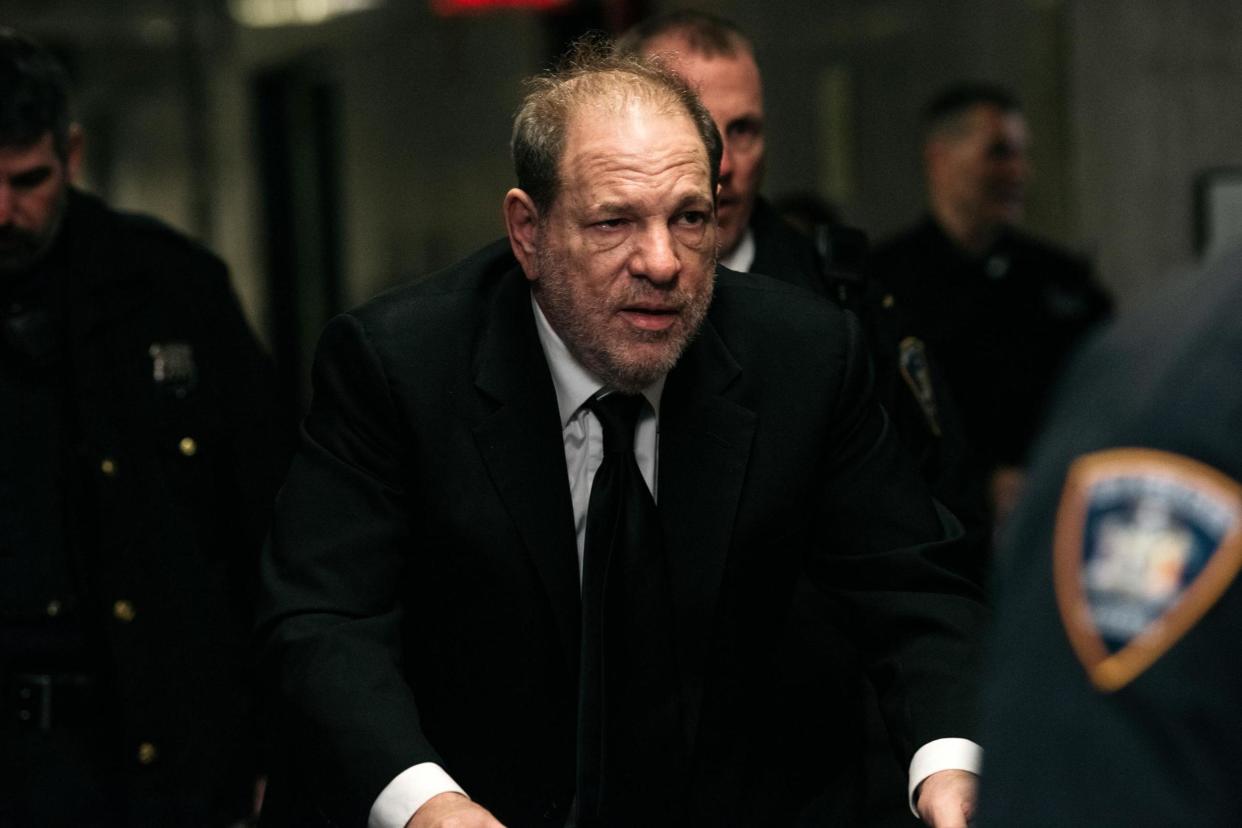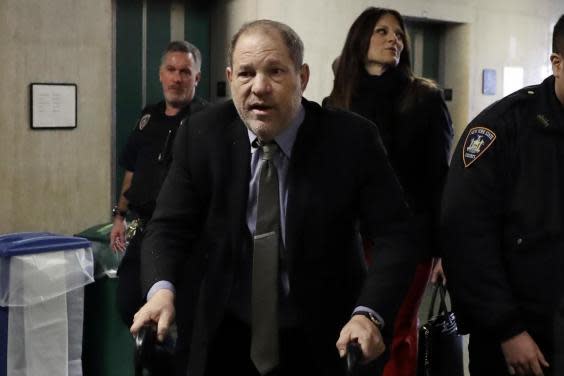Harvey Weinstein trial: From 100 allegations to six women on the stand. Now one jury decides fate of #MeToo movement

The uncomfortable morning routine for Harvey Weinstein has been the same for most of the past three weeks, and typically starts with him pulling up in a car outside the imposing New York County Supreme Court building, a short walk from Brooklyn Bridge.
Stooped, slow, and stubbled, he’d generally rely on a walker stabilised with two tennis balls as he made his way through the media gauntlet, metal detectors, and up several floors to the courtroom.
It is all a far cry from his days as a Hollywood power broker who would swagger down the Oscars red carpet, chuckling with the world’s A-listers.
For three weeks he sat in the sparse courtroom as a series of witnesses recounted his alleged assaults, painting a bleak picture of the private life of the producer whose films notched up 300 Oscar nominations.
When the prosecution rested its case, the defence followed up with just three days of testimony before wrapping up. Soon, a jury of seven men and five women will consider his fate.
As the trial got under way last month Weinstein was stoic, perhaps as the gravity of his position hit home.
But as he grew accustomed to his new surroundings and routine he grew visibly more relaxed – chatting to friends in the public gallery during lulls in proceedings, at one point appearing to doze off, and even smiling and laughing with reporters as he left the room.
Day one began with a blistering opening statement from assistant district attorney Meghan Hast. In one instance, she turned to point at Weinstein, branding him a rapist and detailing descriptions of his alleged assaults.
The defence would go on to paint him, over several days of searing testimony, as a manipulative abuser with a pattern of pushing his victims’ boundaries before finally assaulting them.
The seriousness of the offences he is charged with cannot be understated. He is accused of raping a woman in 2013, and performing a forcible sex act on another woman in 2006.
He has pleaded not guilty and denied all allegations of non-consensual sex. If convicted, he could languish behind bars for the rest of his life.
While the case revolves around the victims of the two alleged offences at hand, the prosecution relied on a New York State law which enabled them to discuss so-called “prior bad acts” to bring forward four other witnesses who detailed their own accusations against the fallen mogul.
Other prosecution witnesses were there to bolster the testimonies of the alleged victims. Among them was Dr Barbara Ziv, a forensic psychiatrist who attempted to deconstruct common misconceptions about sexual assault, telling the jury among other remarks that most survivors remain in touch with their attackers.
Ziv’s testimony embodied the conflict at the heart of the courtroom: the prosecution helping to deliver searingly emotional accounts of abuse, followed by the defence team trying to undermine the witness credibility and sow doubt in the mind of the jurors.
Cross-examination of prosecution witnesses was tough. One key witness, who alleges that Weinstein raped her twice in 2013, broke down in tears during cross-examination early in February, prompting the judge to adjourn her testimony until the next day.
That moment served as a reminder of the personal stakes in a trial considered by many as a historic event – the second major trial of the #MeToo movement since Bill Cosby’s conviction in 2018. The Weinstein trial was spurred on by explosive reports published by The New Yorker and The New York Times in October 2017. At the time, Gwyneth Paltrow, Angelina Jolie, Rosanna Arquette, Judith Godrèche, Asia Argento and more came forward against Weinstein, unleashing a wave of testimonies that forever changed the way many thought about the entertainment industry and its power dynamics.
On the first day of the Weinstein trial, seven of the women who have spoken out against the former movie mogul gathered outside the courtroom to give joint statements to the media. Rosanna Arquette, Rose McGowan, Sarah Ann Masse, Dominique Huett, Lauren Sivan, Louise Godbold and Paula Williams, most of them wearing red, huddled together as McGowan addressed Weinstein as such: “You brought this upon yourself by hurting so many, you have only yourself to blame." Arquette chose to reference the Time’s Up movement: “As we stand here at the beginning of a new year and a new decade, time’s up on sexual harassment in all workplaces. And time’s up on the pervasive culture of silence that has enabled abusers like Weinstein.”
Ahead of the trial, some high-profile potential witnesses were brought up in court, including Salma Hayek and Charlize Theron. While the two actors didn't end up taking the stand, Sopranos actor Annabella Sciorra did so on behalf of the prosecution, alleging that Weinstein raped her in the Nineties. Rosie Perez, the star of Do The Right Thing, supported Sciorra's testimony the following day.
The trial, understandably, has drawn worldwide attention. With no overflow room for the world’s media, journalists, court sketch artists, women’s rights activists, and members of the public had to line up outside court in the small hours of the morning hoping to secure a seat in court.
Big-hitter media organisations paid interns and odd-job takers to camp out to secure the prime positions for their coiffed correspondents, who’d arrive moments before the court opened.
On some days, the trial crackled with tension and while displays of sentiment aren’t encouraged in the courtroom – reactions could not be stifled at times.
One such instance came when the woman who alleges that Weinstein raped her in 2013 gave a graphic description of the producer’s body – and an audible stir, a sharp collective intake of air was triggered.
As well as the allegations themselves, Weinstein’s health became a talking point, too.
Prior to the trial, the producer had appeared in public with his walking frame, which many had seen as a possible stunt and a plea for sympathy.
On the day of the opening argument, Weinstein wobbled into the courtroom without the walker, almost falling and having to reach out to a member of his entourage for support.
One long-time Harvey watcher in the press gallery dismissed claims that it was all an act: “It’s not fake. He’s in bad shape and he needs the walker.”

He also pondered how Weinstein’s health would hold up even in the event of an acquittal. “Even if he’s found not guilty, he might not have long left.”
The discourse continued between the prosecution and the defence, until Judge James Burke told the prosecution it was fine to mention Weinstein’s physical appearance in closing arguments, but “leave the walker out of it”.
The judge, a middle-aged, measured, bespectacled man, has been called to play a pivotal role in proceedings, amid acrimonious questioning and cross-examination of witnesses, and a defence team that repeatedly demanded a mistrial be called.
He first notably inserted himself into proceedings shortly after the trial began, reprimanding Weinstein and warning him that he could be jailed for life for using his mobile phone.
Courtroom guards demanded strict adherence to the mobile phone ban, wandering down the central aisle like exam invigilators and scanning the rows for clandestine screens. Only accredited members of the press corps were allowed to use laptops.
Week after week, some familiar faces were spotted among the crowd. There was Ken Auletta, a veteran New Yorker writer who doggedly pursued the case against Weinstein and is now working on a biography. There was Jia Tolentino, also from The New Yorker, who observed that “the most effective way of undermining the #MeToo movement is to pretend that it has already won – to pretend that centuries of male domination have been swiftly reversed to make women the rulers of the land”. Weinstein’s defence team, including his lawyers Donna Rotunno and Damon Cheronis, became easily recognisable figures as photos of their entrance and exits from court were pinged around the world.
The gap between the publicly funded prosecution and Weinstein’s high-profile defence team was, at times, vivid. Each team vied fiercely for the attention of jurors selected through an arduous, two-week process.
Dozens of potential jurors (including model Gigi Hadid) were dismissed ahead of the trial, mainly over neutrality issues – some after they said they’d read Catch and Kill, Ronan Farrow’s book about the case. Three alternate jurors were also asked to follow the proceedings in case one of the main 12 had to drop out.
While the prosecution put witnesses on the stand for about three weeks, the defence stopped on Monday after just three days, having called to the stand, among others, an expert on human memory and the former roommate of the woman who alleges Weinstein raped her.
Closing arguments will begin on Thursday, with Weinstein’s defence going first, followed by the prosecution by the end of the week. The judge will then instruct the jury to start deliberating in order to reach a verdict.
If Weinstein’s Rolls Royce legal team manage to have him acquitted, celebrations will likely be muted: another case awaits him in Los Angeles, where charges were filed the day before jury selection began in the New York case.

